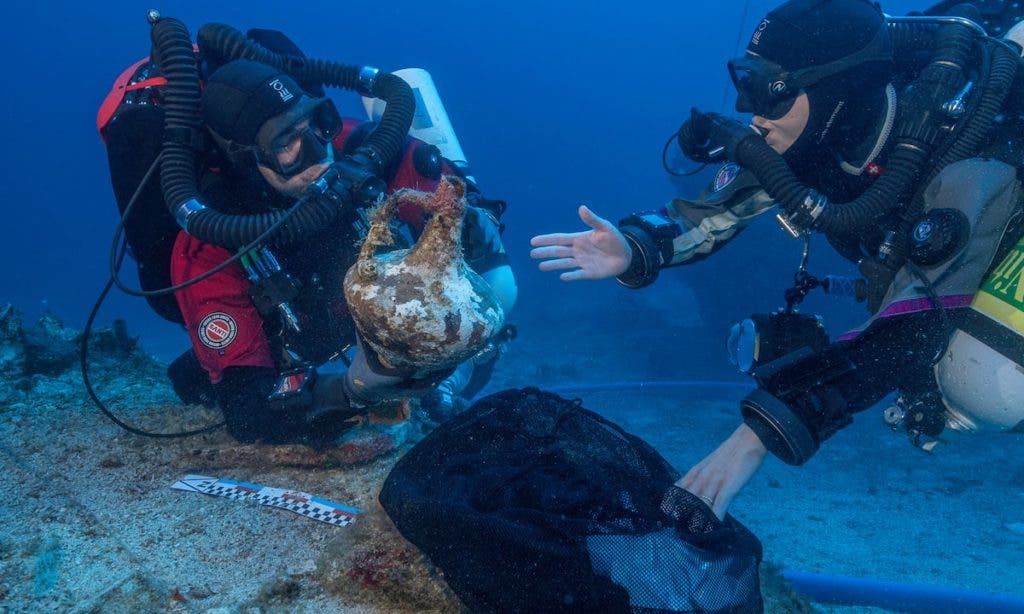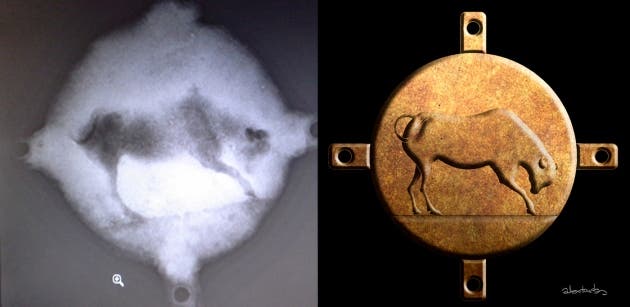The Antikythera shipwreck, one of the most interesting archaeological sites in the world, just got even more fascinating. Researchers discovered a bronze arm and they now believe at least seven life-sized statues are nearby.

When marine archaeologists discovered the Antikythera mechanism, they were stunned. The Ancient Greeks had basically created an analog computer which could also predict astronomical positions and eclipses. It could even track the four-year cycle of the ancient Olympic Games. Nothing like it had ever been discovered, and nothing like it has been discovered since. However, the site itself turned out to be even more interesting. Archaeologists have been studying it for 100 years, finding more and more artifacts every time. During the latest expedition, they recovered a trove of treasures, including bronze and marble statue pieces, a sarcophagus lid and a mysterious bronze disc decorated with a bull.
Most notably, they found the right arm of a life-sized statue, but also several ‘orphan’ pieces, which seems to suggest that more statues await discovery on the bottom of the sea.
“What we’re finding is these sculptures are in among and under the boulders,” said Brendan Foley, co-director of the excavations team at Lund University. “We think it means a minimum of seven, and potentially nine, bronze sculptures still waiting for us down there.”

The bronze arm likely belongs to a male statue, and it is “extremely exciting,” says Kenneth Lapatin, curator of antiquities at the J. Paul Getty Museum in Los Angeles, California. Just a few bronze statues survive from the ancient world, and most of them have been tampered by collectors and curators. While these new statues are heavily corroded, they have been isolated from human interference, and researchers believe they can teach us a lot about ancient techniques.
“Technology has improved so much,” says Lapatin. “We can learn from these untreated finds.”
Many archaeologists around the world have echoed Foley’s and Lapatin’s enthusiasm. Fresh, untreated finds documented by professionals can reveal a surprising amount of information when analyzed through the lens of modern science. Researchers might even be able to identify the people behind the statues and compared them with other existing depictions.
“The chance to recover another group of lifesize statues associated with the wreck is extraordinary, because bronzes are usually encountered randomly under the sea, picked up by fishing nets or chanced upon by divers,” Lapatin said. “Those finds are not excavated like at Antikythera, where archaeologists can and do document the entire context, which provides all the sorts of very valuable data as to when the sculptures were transported and why they were on the ship: for trade, as booty, or as scrap metal to be recycled.”
The expedition also retrieved an intriguing bronze disc or wheel, which seemed to resemble the Antikythera mechanism. It was covered by a layer of hardened sediment, and researchers had hoped X-ray studies would reveal internal mechanisms. However, they saw something completely different: an image of a bull. This indicates that the disc was decorative. Further, more detailed X-rays will hopefully reveal more about its design and purpose. Divers also brought back a beautiful red marble sarcophagus lid.

The Antikythera site is basically a Roman-era shipwreck from the first century BC. It was first discovered by sponge divers in 1900, and it quickly became popular among archaeologists. Although the Antikythera mechanism is regarded as the most important finding, it was the statues that gave the site its initial fame. Over more than 100 years of expeditions of research, the site has yielded numerous coins, and other artifacts. Archaeologists believe there is still much to recover.
The problem is that much of the ship is now covered by giant boulders, potentially displaced by an earthquake. As if underwater archaeology wasn’t difficult enough, this adds a whole new layer of difficulty. The next expedition is scheduled for May 2018.



